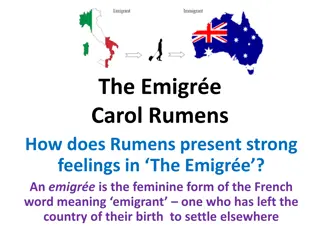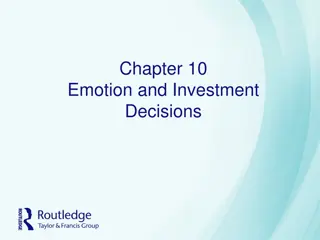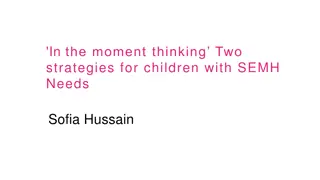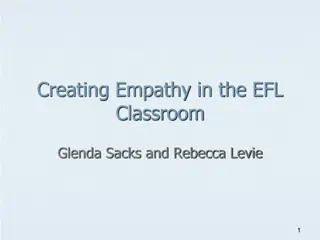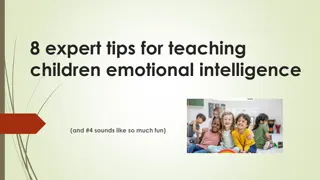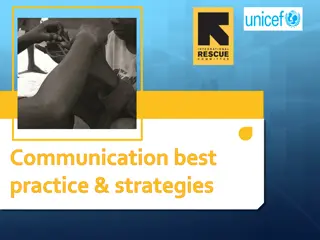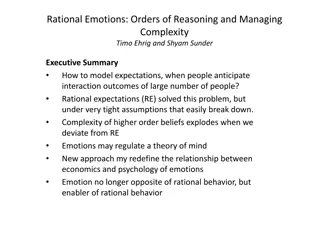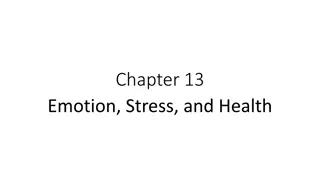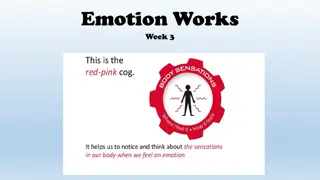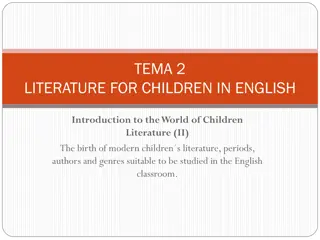Effective Strategies for Helping Children Manage Their Emotions
Inhibiting a child's emotions is not useful; rather, watching for early warning signs and practicing affect mirroring can be beneficial. Understanding and labeling emotions, as well as utilizing mindfulness techniques, help children manage their emotions effectively.
Download Presentation

Please find below an Image/Link to download the presentation.
The content on the website is provided AS IS for your information and personal use only. It may not be sold, licensed, or shared on other websites without obtaining consent from the author. Download presentation by click this link. If you encounter any issues during the download, it is possible that the publisher has removed the file from their server.
E N D
Presentation Transcript
QUESTIONS What s NOT useful for helping a child to manage their emotions? What s useful?
Whats NOT useful for helping a child manage their emotions? Inhibition. There s a fair amount of evidence now that simply telling a child not to feel an emotion does not help them at all! We all still do this though! how many parents have you seen at the school gates on the first day of term parents saying to a crying child: it s going to be fine, you ll make lots of new friends! [See notes also on going back to school.]
Whats NOT useful for helping a child manage their emotions? There s also evidence that, when you re deep into a tantrum, that different management techniques don t actually make much difference to how long the tantrum lasts. We can think of this like a black hole - the deeper in you are the harder it is to get out, and there s a moment called an event horizon beyond which it s impossible to escape. Potegal, 2003
Whats NOT useful for helping a child manage their emotions? There s also evidence that getting cross at a child can make their behaviour worse. The calmer you are, the more that will help. [Although it s a bit more complicated than this! See notes on stress contagion.]
What IS useful for helping a child manage their emotions? Watching carefully for early warning signs trouble brewing early warning signs that there s the signs might be unexpected ones if you do manage to catch it early then shifting the child s attention can help You can buy little bracelets that warn you when a child s internal stress levels are increasing
What IS useful for helping a child manage their emotions? There is also evidence that affect mirroring reflecting back to the child how they re feeling can help. affect mirroring simply Children aren t born knowing what different emotions are! Being able to put verbal labels on emotions helps describe them to others but also to understand them ourselves. Mindfulness which is an effective technique for adults too spreads out the activation patterns of emotions across the brain which might make them easier to manage. Dunning et al., 2019 Lutz et al., 2014
What IS useful for helping a child manage their emotions? This is one reason why girls who often have better language skills than boys at pre-school age often show better emotion management at this age, too. Dunning et al., 2019 Lutz et al., 2014
What IS useful for helping a child manage their emotions? For you being able to affect mirror means being able to imagine what a particular situation feels like from the child s point of view. Sometimes you ll be good at this and sometimes you won t. When we re stressed or anxious, or in a low mood state (depressed) we tend to experience things more from our own point of view. That s nobody s fault it s just one of the things that anxiety and depression does but it does change how we interact with children around us.
What IS useful for helping a child manage their emotions? Another thing that can help is feeling in control feeling in control. Everyone finds it stressful to feel out of control. And children, who live life so much in the moment, are in control of much less than adults. Any way to fake a feeling of control like getting to choose which pencil case to take to school, or which half of their pile of spinach they eat can help.
What IS useful for helping a child manage their emotions? Getting a child to shift a tantrum towards kicking, throwing or stamping and away from crying away from crying can help tantrums featuring crying tend to be more long-lived maybe by holding a cushion and asking them to punch it. Potegal, 2003
What IS useful for helping a child manage their emotions? People pick up on emotions in people around them so if you re calm this helps people calm down. And this emotion contagion works better with physical contact. Gentle touch is always calming particularly for children who don t get it much at home. This is sometimes called kangaroo care kangaroos tend to carry their young with them. kangaroo care because Waters et al., 2015
What IS useful for helping a child manage their emotions? Music and songs Music and songs help for a variety of reasons. First, our heart rates are affected by music, and childrens heart rates tend to go up and down really fast. We think that music, with a regular beat, can help a child s heart to stop yo-yoing up and down
What IS useful for helping a child manage their emotions? but singing also forces you to take big deep breaths i.e. to breathe as if we are calm! One proven emotion management technique is fake it until you make it you make it acting as if we re feeling an emotion can make us actually feel that emotion! fake it until So breathing as if you re calm by singing can help you feel calm.
References Dunning, D. L., Griffiths, K., Kuyken, W., Crane, C., Foulkes, L., Parker, J., & Dalgleish, T. (2019). Research Review: The effects of mindfulness based interventions on cognition and mental health in children and adolescents a meta analysis of randomized controlled trials. Journal of Child Psychology and Psychiatry, 60(3), 244-258. Lutz, J., Herwig, U., Opialla, S., Hittmeyer, A., J ncke, L., Rufer, M., ... & Br hl, A. B. (2014). Mindfulness and emotion regulation an fMRI study. Social cognitive and affective neuroscience, 9(6), 776-785. Potegal, M., & Davidson, R. J. (2003). Temper tantrums in young children: 1. Behavioral composition. Journal of Developmental & Behavioral Pediatrics, 24(3), 140-147. Potegal, M., Kosorok, M. R., & Davidson, R. J. (2003). Temper tantrums in young children: 2. Tantrum duration and temporal organization. Journal of Developmental & Behavioral Pediatrics, 24(3), 148-154. Waters, S. F., West, T. V., Karnilowicz, H. R., & Mendes, W. B. (2017). Affect contagion between mothers and infants: Examining valence and touch. Journal of Experimental Psychology: General, 146(7), 1043.




